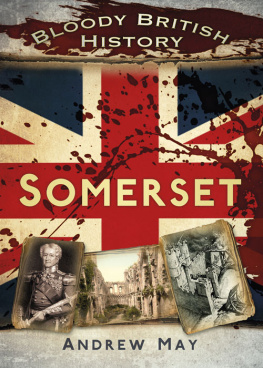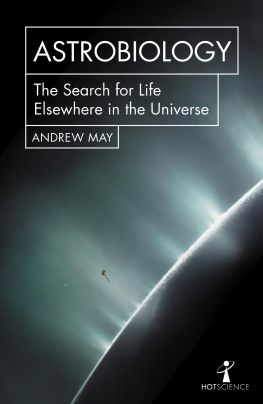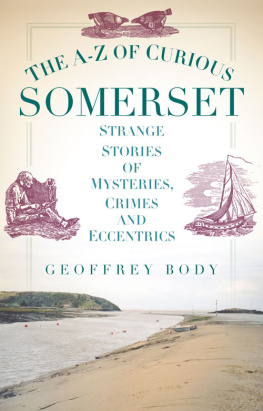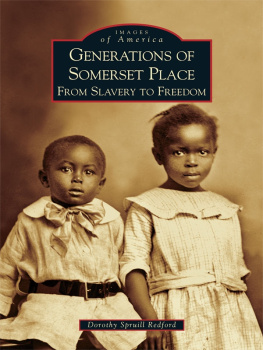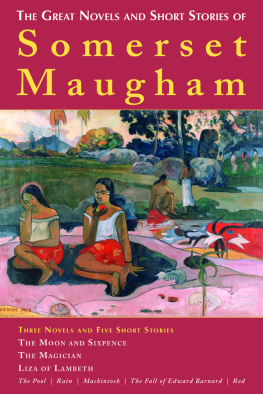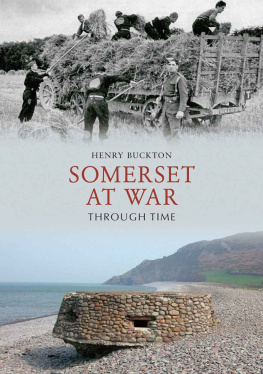
CONTENTS
S OMERSET HAS A history spanning more than 10,000 years, from the prehistoric cannibals who lived in Cheddar Caves to the concrete gun emplacements, airfields and production lines of the twentieth century. Much of that history has been violent. The county has been attacked by merciless Romans, bloodthirsty Vikings and ruthless Normans, and valiantly defended by King Arthur in legend, at least and by Alfred the Great. It was the site of the decisive Battle of Peonnum in 658, and just over 1,000 years later, in 1685, the equally decisive Battle of Sedgemoor, the last full-scale battle fought on English soil.
People from Somerset have played leading roles in some of the bloodiest events in British history. When Archbishop Thomas Becket was brutally murdered in 1170, it was a Somerset man who struck the fatal blow. When King Edward II had a red-hot poker thrust up his backside in 1327, it was a Somerset man doing the thrusting. When Parliament voted to execute King Charles I in 1649, the vote was rigged by a Somerset man!
The following pages take you on a guided tour of Somersets history, with all the tedious bits missed out an experience guaranteed to be exciting, dramatic and bloody!
12,700 BC
The men launched a fusillade of spears against the herd of animals stampeding through the narrow gorge. When the dust had cleared, three of the animals lay dead as well as one of their own number, who had been gored to death. A good haul: four edible carcases
L ONG BEFOREHomo Sapiens arrived in Somerset, there was Homo Neanderthalensis. Forty thousand years ago, most of Britain was covered by a vast sheet of ice but the ice stopped just north of the Mendips. The rocky landscape to the south of the ice was roamed by huge animals: mammoths, woolly rhinoceroses, giant bears. These great beasts were hunted by hyenas, and by something else: a strange creature that walked upright and hurled wooden spears with tips made of sharpened stones. Neanderthal Man had arrived on the scene!
The Neanderthals werent the smartest people that ever lived, but they were a lot smarter than anything else that was around at the time. Like the hyenas, they ate the animals they killed but unlike the hyenas, they carefully removed the skins and used them to make clothing for themselves. They shared Coopers Hole at Cheddar and the Hyena Den at Wookey Hole with the hyenas, but it was the Neanderthals who made the stone axes and built the fire-hearths that have been found there.
The Neanderthals were around for a long time, but eventually they were forced south by the ever-encroaching ice sheet. From 24,000 BC until the end of the Ice Age in 8000 BC with one brief exception Somerset was too cold for human habitation. That one brief exception rejoices in the name of the Late Upper Palaeolithic, and its a strong contender for the goriest period in the regions history.
Around 12,700 BC , for reasons no one really understands, there was a dramatic rise in temperature across the whole of the Northern Hemisphere. For a few centuries the Ice Age was put on hold, and southern Britain became almost as warm as it is today. Animals that for thousands of years had been confined to southern Europe suddenly started to migrate to the north. Wild horses, red deer and cattle arrived in Somerset. And the human hunters who preyed on them came hard on their heels.

Neanderthal Man. ( Mark North)

Woolly mammoths roamed prehistoric Somerset.
These were Homo Sapiens modern humans, not Neanderthals. A small group of them settled in Cheddar, which suited them for two reasons: firstly, the caves provided shelter; and secondly, the gorge which was even narrower in those days than it is today provided a natural killing ground for the animals they hunted. Acting as a co-ordinated team, one group of men could frighten deer or cattle into the gorge, while another group picked them off in a classic ambush.
The centre of the Cheddar community was the huge cavern now known as Goughs Cave. Deep inside so deep that modern-day tourists can only see their way with the aid of electric lighting there is a wall carving dating from this period which clearly depicts a mammoth. Its the oldest work of art in Britain, and it proves that the people of Late Upper Palaeolithic Cheddar werent complete savages or does it?
In the 1980s, scattered human remains were discovered inside Goughs Cave that have been dated, near enough, to that critical date of 12,700 BC . The remains came from five individuals: a young child, two older children, and two adults. The bones were mixed up with the remains of various species of animals, and all the bones human and animal showed clear signs of butchery. The people who lived in Goughs Cave in the Late Upper Palaeolithic werent just meat-eaters they were cannibals!
Four of the skulls show scratches inflicted by flint knives, where the scalp was cut away. The eyeballs were scooped out, and the skulls inverted over a fire to cook the brains. There are cut marks on the lower jawbones, where the muscles were severed to remove the jaw for easier access to the brain. The lower jaws were split in two to get at the tongue. The long bones of the arms and legs were cracked open so the marrow could be scooped out.
Cannibalism may sound barbaric, but in the harsh conditions of the Late Upper Palaeolithic it was nothing but simple common sense. Food was in short supply so if a child or elderly person died, why not make the most of what they had to offer? Brains, tongues, eyeballs and bone marrow are all highly nutritious, and allowing them to go to waste would have been foolish sentimentality.
The respite from the Ice Age was brief, and before long the cold weather was back with a vengeance. People migrated south, and Somerset was left devoid of human occupation until the ice sheet finally receded around 8000 BC. This time, when Homo Sapiens came back, they were here to stay.
Britains oldest complete skeleton was discovered at Cheddar in 1903. It belonged to a hunter-gatherer who lived around 7000 BC, and has been dubbed Cheddar Man. Amazingly, Cheddar Man was found to have DNA in common with his cannibalistic predecessors of the Late Upper Palaeolithic. But Cheddar Man was far more sophisticated than they were. He would have had a range of weapons, including a harpoon for hunting fish and waterfowl, and a bow and arrow to bring down small animals at a much longer range than a throwing spear. The weapons and tools of the period were still made of stone, but they were extremely finely worked when theyre unearthed today, many of them are still sharp enough to inflict a nasty cut!
A few miles north of Cheddar, Avelines Hole near Burrington is the oldest known cemetery in Britain. In the eighteenth century it was found to contain about 100 skeletons, but most of them were appropriated by souvenir hunters. By the early twentieth century, only twenty skeletons remained, and they were carefully moved to a museum in Bristol where most of them were destroyed by a Second World War bomb! The few fragments that remain have since been dated to c.8000 BC about 1,000 years older than Cheddar Man.

Next page
